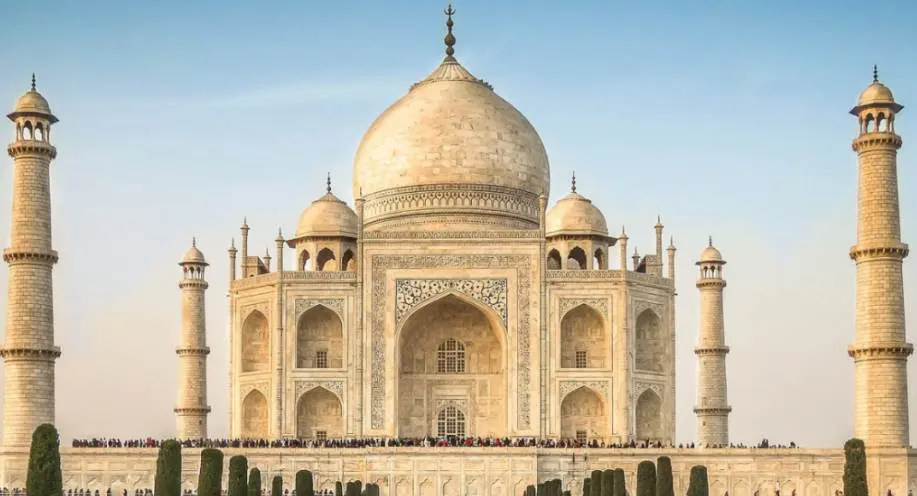This ivory-white building is located on the South Bank of the Yamuna River in the city of Agra in India and is one of the 7 wonders of the world today.
If you want to get a clearer picture, Agra is located about 206 kilometers (128 mi) south of New Delhi in the state of Uttar Pradesh. That’s in the central part of North India.
So what’s the story of the Taj Mahal? Who constructed it? And why? This and many other facts about the Taj Mahal will be clarified in this post.
1. The story of the Taj Mahal
Once upon a time, there was an emperor named Shah Jahan. He had a beautiful wife and 13 children.
His wife, named Mumtaz Mahal, was pregnant with their 14th child when the unthinkable happened. She died of complications giving birth to a child named Gauhar Ara Begum.
The emperor was completely devastated. He couldn’t think of anything else than to honor his deceased wife by creating a tomb that would stand the test of time. A mausoleum that would be visited by people from all over the world to witness the eternal love he had for his favorite wife.
That’s the story of the Taj Mahal. The love for his wife gave emperor Shah Jahan enough inspiration to create a magical building, and he succeeded in his quest.

2. When was the Taj Mahal Built?
The wife of emperor Shah Jahan, which full name was Shahab-ud-din Muhammad Khurram, died in 1631.
It took the emperor a year to recover from his traumatic loss and construction started the year after in 1632.

Considering the scope of the project, it’s no wonder that the total time to finalize the construction was over 2 decades, even though the mausoleum itself was already completed in 1643.
The Taj Mahal in its entirety was completed in 1653.
3. What architectural style is the Taj Mahal Built-In?
Shah Shahan was emperor of the Mughal Empire. He was the most competent emperor they ever had. During his reign, the Mughal Empire witnessed its glory period, and this translated into the height of Mughal architecture.
This type is a form of Islamic architecture that has a uniform structure. It can easily be recognized by its domes and slender minarets at the corners.
Apart from the Taj Mahal, another great example of Mughal architecture is the Badshahi Mosque, in Lahore, Pakistan. This was the biggest mosque in the world for 313 years and the last of the imperial mosques built by the Mughals.

4. The grave isn’t decorated
There is a Muslim law saying that a grave can not be decorated. Emperor Shah Jahan was an obedient Muslim and followed this law.
The grave of his wife is the only part of the building that doesn’t have elaborate decorations.
And rest assured, all the rest is decorated with such fine detail you don’t have to be surprised that it took over 22 years to complete everything.
5. Money wasn’t an issue
The Emperor was quite rich. He was so rich that he could spend as much as he wanted on the construction of the final resting place of his beloved wife.
It’s estimated that when the construction of the Taj Mahal was completed in 1653, a total amount of 32 Million Rupees was spent on it.
To give you an example, at this moment, this amount is close to 60 Billion Rupees which is an astounding 840 million US Dollars!
6. The lovers are buried together
As one would expect, the Emperor and his wife are buried together in the tomb of the Taj Mahal.
The tombs can be found at the lower level of the building and are the main focus of the entire construction.
An interesting fact about the Taj Mahal tombs: The cenotaph of Emperor Shah Jahan is the only visible asymmetric element in the entire Taj Mahal complex.
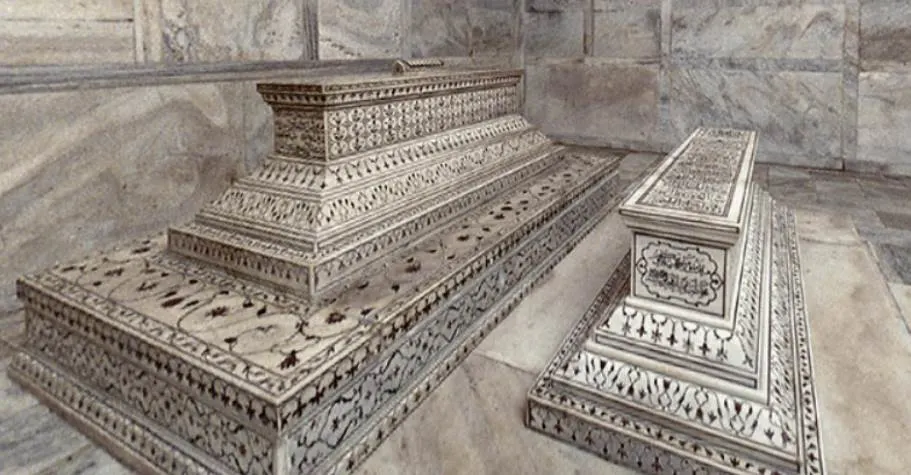
7. Taj Mahal decorations
We can fairly conclude that the Taj Mahal is the epitome of Mughal architecture. Both the exterior and interior decorations are of the finest conceivable.
Especially the caligrapher at the time, a man named Abdul Haq (given the title of “Amanat Khan” by the Emperor), played an important role.
Because the caligrapher was “writing the word of God” and he was so good at what he was doing, he was allowed to immortalize himself on the walls of the Taj Mahal.
We can consider it to be a signature that humbly reads:
“Written by the insignificant being, Amanat Khan Shirazi.”
8. The Taj Mahal consists of multiple buildings
The Taj Mahal isn’t just a massive tomb. It’s a complex that consists of multiple buildings. Here’s an overview:
- Entrance Gates – There are a total of 3 entrance gates. Especially the main entrance gate is a stunning work of art in itself.
- Mosque – One of two red sandstone buildings at the end of the complex is a mosque that faces the side of the actual tomb.
- Jawab – On the other side, facing the mosque and the other side of the tomb is a similar building considered to be a guesthouse. Its main purpose is believed to have been to maintain the symmetry of the complex as it doesn’t contain a Mihrab (element in the mosque facing Mecca) and prayer rugs in black marble as the mosque does.
- Walls – On 2 sides, the building is bordered by red sandstone walls. The only side that isn’t bordered by a wall is the side of the Yamuna river.
- Mausoleums outside the walls – Even outside the walls bordering the main structure are other mausoleums. Those include the final resting places of the other wives of Shah Jahan and that of Mumtaz’s favorite servant. Interestingly enough, the tomb of the servant is the largest outside the walls.

9. Facts about the garden of the Taj Mahal?
The original garden of the Taj Mahal followed the Mughal architecture making it a Persian-style garden. This consists of raised marble pathways, an elevated marble water tank, and avenues of trees.
During the reign of the Mughal, the garden also had a lot of vegetation such as roses, fruit trees, and multiple other types of flowerbeds.
When the British came to control large parts of India, they also took control of the Taj Mahal, of which the garden had turned into a wilderness.
The result: The garden now looks like any other garden in the UK, covered with green lawns.

10. The concern of a collapse of the Taj Mahal
No matter how glorious and amazing the Taj Mahal looks, it’s been in a state of decay for a long time.
And more worrisome is the fact that very little is being done to solve the issues. If nothing is done soon, the concern that parts of the mausoleum will collapse becomes awfully real.
It has come to the point that India’s supreme court gave the Indian government 2 choices:
- Restore the Taj Mahal
- Or demolish it
We can only hope the apathy will disappear and a solution for restoration will come very soon, so this architectural wonder will stay with us.
11. Concerns of collapse aren’t new
The moment the Taj Mahal was being constructed, Shah Jahan was very wary of the tomb of his deceased wife being destroyed in case of a collapse.
Because of his fear, the building was constructed in such a way that everything would fall away from the tomb in case of a collapse.
Positioning the 4 minarets on the corners wasn’t a choice of retaining the symmetry or enhancing the visual appeal. They were strategically positioned there to avoid damage to the tomb in case they would fall over.
Better yet, they are leaning outward to ensure they would fall away from the tomb as well.
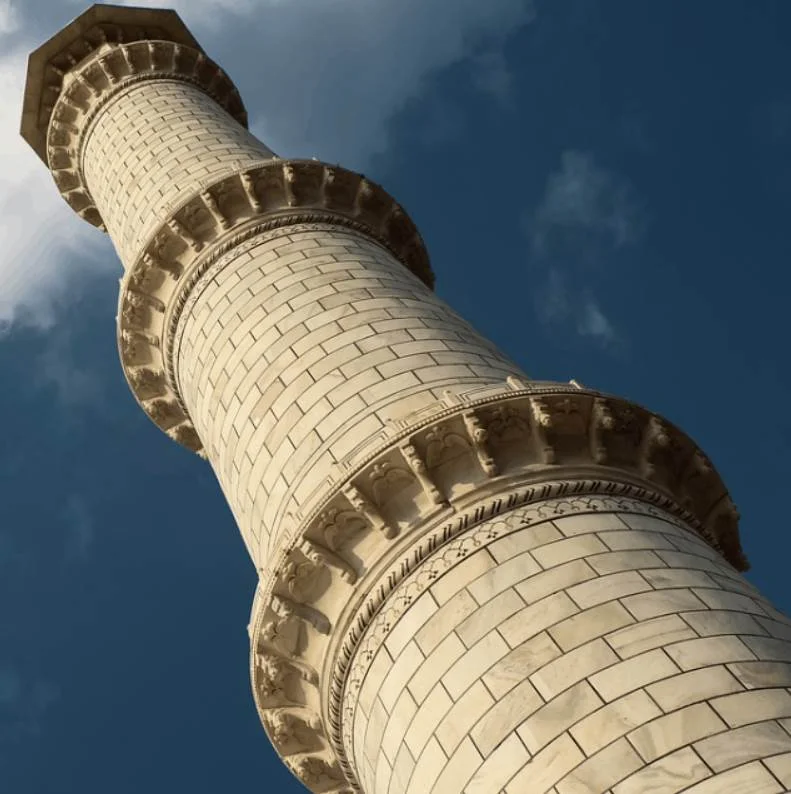
More interesting facts about the Taj Mahal
12. Building the Taj Mahal was a huge endeavor. It didn’t only take over 22 years to complete the complex, there were also more than 20,000 people directly involved in its construction and decoration.
13. So how did the stones arrive at the site? They were pulled there with elephants. And we’re not talking about something like the 28 horses that pulled the bell of the Sacré-Coeur up the Montmartre hill in Paris, we’re talking about a caravan of 1,000 elephants laboring away to bring in the building materials.
14. The French merchant and traveler Jean-Baptiste Tavernier was the first European to lay eyes on the Taj Mahal during a visit to Agra in 1665. He actually had an encounter with Shah Jahan during his visit (as a seller of costly jewelry), which was just one year before the Emperor died.
15. One remarkable story about Tavernier’s visit is that Shah Jahan claimed he intended to build a black Taj Mahal across the river. This would then become his ultimate resting place. The plan didn’t go through as he got into a conflict with his sons and was put under house arrest in the final years of his life.
16. The mosque is an active one. Every Friday the mosque is closed for tourists for the prayer to take place.
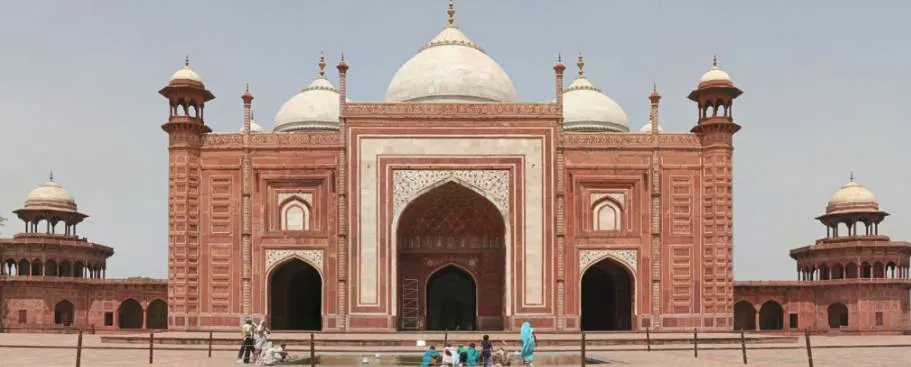
17. Decorating the Taj Mahal was serious business. No less than 28 semi-precious stones were sourced from multiple countries to garnish it. These countries include Tibet (turquoise), China (jade), Sri Lanka, and various parts of India.
18. The architect in charge of the 20,000 workers that built the Taj Mahal was not Indian but from Persia. His name was Ustad Ahmad Lahori.
19. The site the Taj Mahal is built on and that is located on the south bank of the Yamuna river encompasses an area of 17 hectares (42 acres).
20. There is a myth that the architects and engineers who helped to design the Taj Mahal were put to death when the construction ended. This has been refuted and it’s more likely that they were made to sign a contract they would never create such a magnificent thing of beauty ever again (or get inspiration from it).
21. The Indians weren’t too happy with the rule of the British East India Company halfway through the 19th century, and an unsuccessful rebellion ensued in 1857. During these times of turmoil, many British soldiers and officials vandalized the Taj Mahal by cutting out precious stones.
22. The last 8 years of Shah Jahan must have been years of utter despair. His very own son Aurangzeb put him under house arrest in Agra Fort. From there he was only able to see the Taj Mahal out of the Jasmine Tower before ultimately being buried there.

23. In contrast to the decay of the Taj Mahal, which is apparently not something on the Indian government’s list of urgent issues, the Taj Mahal was well protected from imminent danger before. During the Second World War and the India-Pakistani wars, scaffoldings were set up to mislead bomber pilots. This is to preserve the Taj Mahal from destruction by bombs.
24. Did you ever see a taxi or a bus driving up to the gate to unload a bunch of tourists in front of the Taj Mahal? You won’t, because cars are banned within 500 meters of the building. This is to keep the white marble as shiny as possible.
25. The foundation of the Taj Mahal consists of timber wood. This isn’t supposed to be used as a foundation for a massive structure like this. If the Taj Mahal wasn’t located on the bank of a river to keep the timber foundation moist and strong, it would have collapsed a long time ago.
26. Agra wasn’t supposed to be the location for the Taj Mahal. Initially, the idea was to build it in Burhanpur, Madhya Pradesh. This is the place where Mumtaz died giving birth to her 14th child.
27. The moods of a woman can change multiple times a day. So does the Taj Mahal, the final resting place of the Emperor’s favorite wife. It shifts color based on the lighting or time of the day. In the morning it appears to be pink, in the day and evening it’s as white as snow, and in the moonlight, it appears to be golden.
28. A replica of the Taj Mahal will be built in Dubai and will be called the “Taj Arabia.” Apart from the fact that it’s 4 times bigger than the original, it has nothing else in common with it.
29. If you’re a poor person living near Dhaka, the capital of Bangladesh, and you really want to see the Taj Mahal, you’re not out of luck. In 2008, a wealthy Bangladeshi film director named Ahsan Ullah Moni announced he would replicate a scaled replica of the famous complex in his country. The total cost of the project: $56 million.
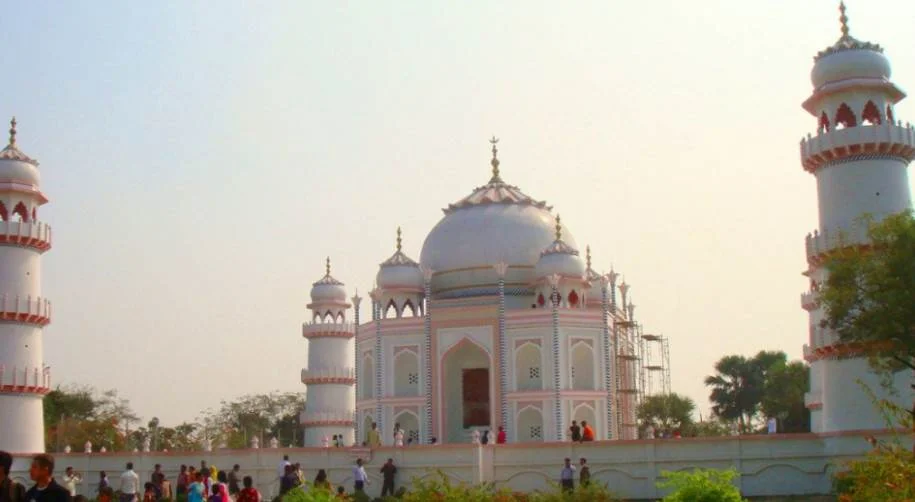
30. If you beat a wall in the Taj Mahal, water will come out of it. At least that’s what a myth is supposed to make you believe. The only certain thing is that a lot of people punch the wall to find out, as guards always find evidence of the wall being slammed.
31. Did Shah Jahan build the Taj Mahal? Everything points to it. Some lawyers though aren’t too sure about this and claim the building is actually a Shiva Temple called Tejo Mahalaya and built in the 12th century. Their goal: To allow Hindus to pray in it. Pleas are going back and forth, and while the claim in itself seems to be far-fetched, the legal battle won’t end any time soon.
32. Lord Curzon who serve as Viceroy of India from 1899 to 1905 ordered the restoration of the Taj Mahal. While he was at it, he also commissioned and gifted a large copper lamp located in one of the chambers. It weighs nearly 60 kilos and has his name engraved into it.

33. The caligrapher of the Taj Mahal did an amazing job. He not only decorated large parts of the building with verses of the Quran, but he also inscribed 99 names of Allah in the tomb.
34. The Taj Mahal is a massive tourist attraction and receives over 8 million visitors every year. On some days, the number of visitors can be over 50,000.
35. The entrance fee for Indian visitors is significantly lower than for foreigners. So much that the price for a ticket in 2019 was just 50 INR for Indians and 1,100 INR for foreigners.
36. Apart from being one of the 7 wonders of the world, the Taj Mahal is also a site that is listed on the UNESCO World Heritage list.
